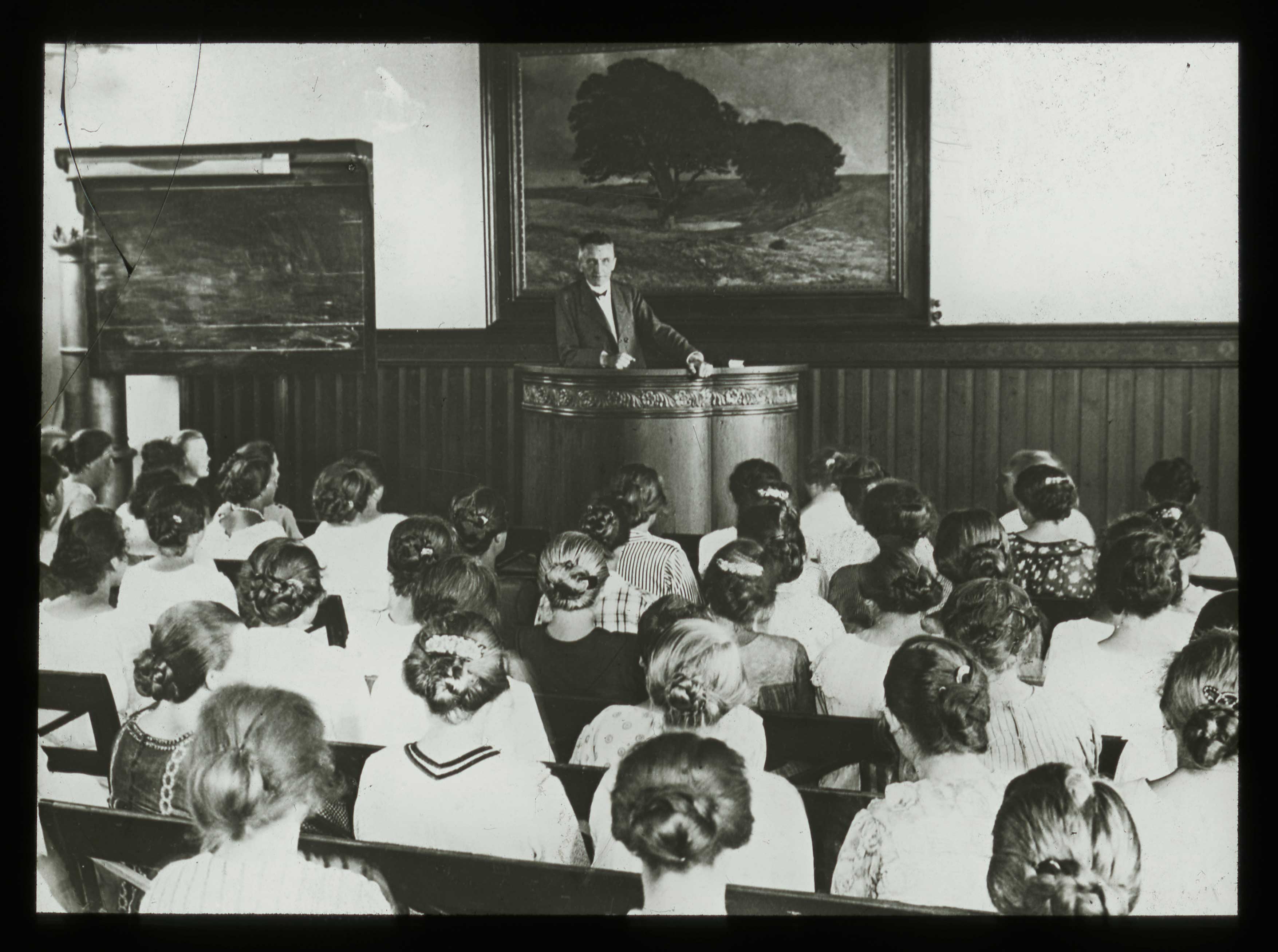Widening the Story - Artifact 1
Colonial Eugenics in White Settler Domestic Science Education
Context
This slide depicted below belonged to Dr. O. M. McConkey (1917-1974). It is one slide from his large collection of eugenics lecture slides.1(footnote) McConkey was Professor of Genetics and Field Husbandry at Ontario Agricultural College (OAC). He lectured on eugenics to Macdonald Institute students as part of their curriculum from 1920 to 1938.
In this image, McConkey presents to a mostly-white, all-female class at Macdonald Institute. McConkey stands at the lecture podium in the photograph. The students sit in rows facing McConkey. We see the backs of their heads. Behind McConkey is a large pastoral painting of leafy green trees in the middle of an open, grassy field. To McConkey’s left is a blackboard and screen for his slide projections.
-

A white male eugenics teacher at a podium, facing a group of white female students in a room at Macdonald Institute circa 1930s to 40s. McConkey’s Eugenics slides courtesy of University of Guelph McLaughlin Library Archival & Special Collections, Ontario Agricultural College, Dept. of Field Husbandry Oswald Murray McConkey Papers, RE1OACA0066 Regional History Collection, Box 15B, Genetic Slides.
×

The academic field of home economics attracted women as students, teachers, and leaders. It emerged as a field of study in Canadian colleges and universities in the early twentieth century and mainly accepted white women and women whose families could pay the tuition fees. The term “home economics” supplanted the term “euthenics.” Euthenics is a term coined by home economics pioneer Ellen Richards to refer to the science of everyday living and the idea that the environment could be controlled to improve Eurocentric notions of family life and, more broadly, human life.2(footnote) After majoring in home economics, some students and graduates joined the eugenics movement because it gave them political influence and authority as child bearers. Others felt that eugenics legitimized home economics as a field of study and housekeeping as a profession. They wanted to make the work of white women in the home respectable and worthy of recognition. Many believed this legitimacy would counter hierarchical theories of human biology that argued women were inferior to men. At the same time, as white women they had a strong desire to be part of a larger colonial eugenic and euthenic “civilizing” mission in the world.3(footnote)
To put eugenics into practice, eugenicists needed a convincing campaign of education. Eugenics education had two main objectives: “(1) the development of an understanding of the principles of heredity to be followed by more specific studies of the theoretical and practical aspects of eugenics, and (2) the intellectual, emotional, and physical development of individuals for the fulfillment of their roles as participants in family life, and especially as parents.”4(footnote)
Leanne Betasamosake Simpson explains a much deeper, long-term, and locally pressing colonial and settler colonial motivation to impose white settler notions of family onto the bodies of ᓂᑕᑦ ᐊᓂᔑᓂᓂᐊᐧᐠ (First Nations Peoples). In her book titled, As We Have Always Done: Indigenous Freedom Through Radical Resistance, Simpson explains how and why white Anglo-Saxon middle class women have imposed domesticity and heteropatriarchy onto ᒥᒋ ᓴᑭᐠ ᐊᓂᔑᓇᐯ ᐃᑫᐧᐊᐧᐠ ᐃᐧᔭᐃᐧᐊᐧ (Michi Saagiig Nishnaabeg women’s bodies) for over 200 years. This gendered ᐅᑭᒪᐃᐧᐣ (governance) asserts white settler sovereignty in an ongoing violation of ᐊᓂᔑᓇᐯᐠ (Nishnaabeg) bodies. ᐊᓂᔑᓇᐯᐠ (Nishnaabeg) bodies are central to a larger political sovereignty--a system actively engaged with non-human life, spirit, Ancestors, and relations to the land. Simpson shows how this violation of ᐊᓂᔑᓇᐯᑫᐧᐠ ᐅᐃᐧᔭᐃᐧᐊᐧ ᐅᑎᐯᑕᓱᓂᐊᐧ (Nishnaabeg women’s body sovereignty) is directly connected to colonial and then settler colonial efforts to claim ever more land and resources.5(footnote)